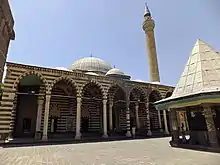| Behrem Pasha Mosque | |
|---|---|
Behram Paşa Camii Mizgefta Behram Paşa | |
 | |
| Religion | |
| Affiliation | Islam |
| Location | |
| Location | Sur, Diyarbakır, Turkey |
 Location within Turkey | |
| Geographic coordinates | 37°54′34″N 40°14′03″E / 37.9094°N 40.2342°E |
| Architecture | |
| Architect(s) | Sinan |
| Type | Mosque |
| Style | Ottoman architecture |
| Groundbreaking | c. 1564/65 |
| Completed | 1572/73 |
| Specifications | |
| Dome dia. (outer) | 15.9 m (52 ft) |
| Minaret(s) | 1 |
| Materials | alternating layers of white limestone and black basalt |
Behrem Pasha Mosque (Turkish: Behrem Paşa Camii, Kurdish: Mizgefta Behram Paşa) is a 16th-century Ottoman mosque located in the town of Diyarbakır in southeast Turkey. It was commissioned by the Ottoman governor-general Behram Pasha.
History
The mosque was commissioned by the local Ottoman governor-general Behram Pasha. He was the son of Kara Şahin Mustafa Pasha who served as the governor-general of Yemen and Egypt. The dates of Behram Pasha's tenure in Diyarbakır are uncertain but were probably between 1564–65 and 1567–68. He died in 1585 and was buried in Aleppo.[1] Building began in around 1564–65 and was completed by 1572–73 (AH 980), the date included in the Arabic inscription carved above the entrance portal.[2] The mosque is attributed to Sinan in one of his two major autobiographies (Tuḥfetü'l-mi'mārīn) but not in the other (Tezkiretü'l-ebniye), which may suggest that Sinan had a marginal role in its design, possibly by approving the plans in Istanbul (the Ottoman capital) to be executed by another architect.[3] The identity of the architect who oversaw the construction is not known but it may have been another imperial architect sent from Istanbul, if not a local master, given the quality of its construction.[2][4][lower-alpha 1] The distinctive use of local features alongside the Ottoman design also suggests that the architect employed a team of local masons and craftsmen.[2]
Architecture
Exterior
An octagonal drinking fountain is aligned with the central portal of the north façade. The pyramidal roof of the fountain is supported by composite black and white columns with braided central sections. The north façade of the mosque is constructed in alternation layers of black and white stone. The double portico has five domes. The two central columns supporting the outer portico have a braided central section placed between alternating layers of black and white stone, echoing those of the fountain. The remaining columns supporting the portico are of white marble. A single minaret sits at the northwest corner of the portico. The mosque itself is in the form of an unlayered domed cube. The dome sits on a sixteen-sided drum which has windows on each of the sides.[2]
Interior
The 15.9 metres (52 ft) diameter dome is supported by eight pointed arches. The dados of the prayer hall are decorated with large square polychrome underglazed tiles. These have a border of two styles of rectangular tiles. The tiles are believed to have been produced locally in Diyarbakır but are very similar to those produced in İznik.[2]
The design of the mosque has been praised by architectural historians.[2] Godfrey Goodwin wrote in 1971: "It is, indeed, the prince of provincial mosques as splendid in its decoration as it is in its proportions within the limits of the severe local style."[5]
Notes
- ↑ Doğan Kuban states more generally that the mosque was "probably designed by an imperial architect sent from the capital."[4]
References
Citations
- ↑ Necipoğlu 2005, p. 467.
- 1 2 3 4 5 6 Necipoğlu 2005, p. 468.
- ↑ Necipoğlu 2005, p. 455, 560.
- 1 2 Kuban 2010, p. 574.
- ↑ Goodwin 2003, p. 310.
Sources
- Goodwin, Godfrey (2003) [1971]. A History of Ottoman Architecture. London: Thames & Hudson. ISBN 978-0-500-27429-3.
- Kuban, Doğan (2010). Ottoman Architecture. Translated by Mill, Adair. Antique Collectors' Club. ISBN 9781851496044.
- Necipoğlu, Gülru (2005). The Age of Sinan: Architectural Culture in the Ottoman Empire. London: Reaktion Books. ISBN 978-1-86189-253-9.
Further reading
- Raby, J. (1977–78). "Diyarbakir: a rival to İznik. A sixteenth-century tile industry in eastern Anatolia". Istanbuler Mitteilungen. 27: 429–459.
External links
- Behram Paşa Camii, Archnet












.svg.png.webp)